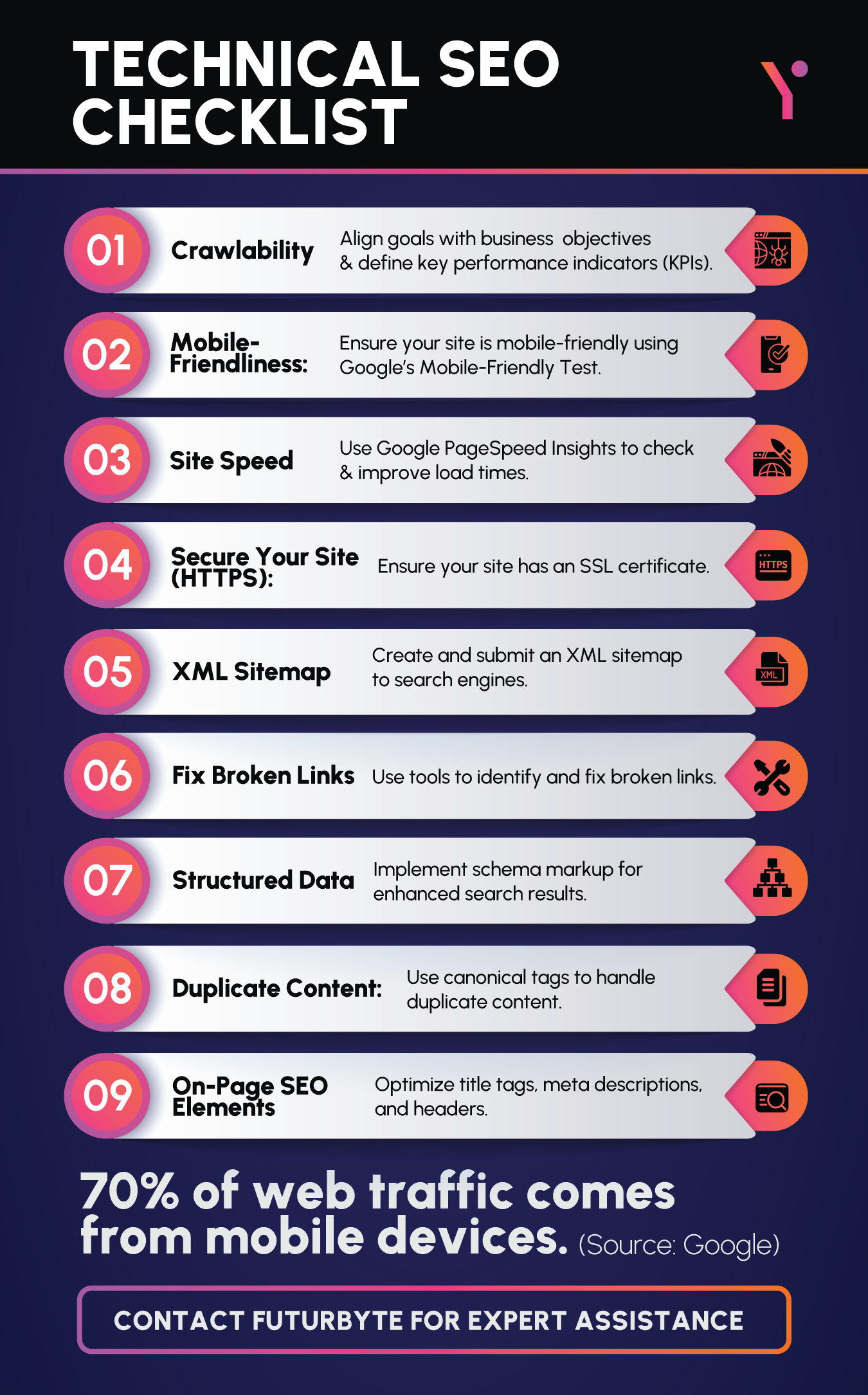Introduction
If your website is performing poorly in search results, then some technical SEO issues maybe holding it back. Read this detailed technical SEO checklist as it guides you in resolving SEO-related issues in your website.
We are living in times where having a robust technical SEO foundation is a necessity, leading to optimal search engine visibility. This is where this guide comes to your aid, as it offers you a beneficial technical SEO checklist, helping you with technical SEO services.
The fundamentals provided here can benefit companies looking to make the most out of SEO, especially those associated with IT, fintech software development, food and beverages, and more so keep on reading the technical SEO checklist 2024 to know more.
Setting the Stage: The Importance of Technical SEO
Here are prominent reasons why technical SEO services matter:
- Enhanced Search Engine Visibility
- Improved User Experience
- Stronger Brand Authority
- Increased Website Traffic
- Better Conversion Rates
Benefits of a Robust Technical SEO Foundation
The positive news here is that when you invest proper time and effort into technical SEO, it will reap immensely beneficial rewards. This is why more and more organisations are taking a deep look into a technical SEO checklist and relying on the services of quality SEO experts such as FuturByte, who are also reputed custom web development service providers.
These are the key benefits attained via a robust technical SEO foundation:
- Decreased crawling budget issues
- Improved content visibility
- Enhanced website performance
- Durable foundation for on-page and off-page SEO
- Future-proofing for website

I. Crawlability and Indexing: A Critical Point in Technical SEO Checklist
Both crawlability and indexing are considered to be the fundamentals of technical SEO. They make sure that search engines find, access and get to know a website’s content. The following is a breakdown of the important elements to optimise:
Robots.txt
The Robots.txt file present on your website tells search engine crawlers which pages to avoid and which to access. You must have a robots.txt file. This is why if you incorrectly use it, search engines will stop crawling important content. Additionally, this is why many SEO experts are promoting the importance of this file in their respective technical SEO checklist.
These are the important points to consider:
- You must disallow access to pages that you don’t want search engines to index. This may include duplicate content or login pages.
- Make use of tools such as Google Search Console to properly test your robots.txt file. Ensure that it does not block essential pages.
Creation and Submission of Sitemap
A sitemap comes as an XML file that lists every important page on a website alongside its associated relationships. Note that the sitemap behaves as a roadmap for today’s latest search engine crawlers, giving them ease in their attempts to both discover and index a given content.
This is how to effectively leverage sitemaps:
- Generate a sitemap that features every important page. Also, regularly update it as you include fresh content.
- Submit your sitemap to major search engines, including the Google Search Console. This will ensure the search engines are aware of the website’s structure.
Do you want to have an even better understanding of crawlability, indexing, or related concepts, such as the benefits of SEO services for small businesses? Contact FuturByte. We are a globally-recognized custom website solutions provider that will be of immense aid to you.
Ensure a Reliable URL Structure
Anyone who is looking to make the most out of a technical SEO checklist should understand that a website’s URL structure plays a critical role in both user experience and crawlability. It is because of consistent and clear URLs that there is ease given to today’s search engines in their attempts to better understand a website’s hierarchy. Additionally, users also get ease as they navigate content.
The following are some of the most practical ways to optimise a URL’s structure, which are commonly found in a technical SEO checklist:
- Include relevant keywords in your URLs. This will offer context regarding a page’s content.
- Try to avoid very long URLs that are difficult to remember and read. Prefer URLs that are descriptive while not being very verbose.
- Utilise separate words in URLs by using hyphens. This will enhance readability.
- Try your best to avoid dynamic URLs that have session IDs and parameters. These can cause confusion for today’s search engines. Try going for easily understandable static URLs.
For more information on this, contact FuturByte. We are a reputed PWA development company that can offer you valuable advice regarding a reliable URL structure.
Internal Linking
Simply put, internal linking is the linking between pages in a given website. It is because of a properly made internal linking strategy that today’s search engines will have ease in understanding the relationships between your content. Also, the strategy will be able to distribute link equity across the website, which will improve every page’s ranking potential.
Leading Internal Linking Practices
- Perform linking to pages that are topic-wise relevant to an existing page. This will aid search engines in their attempts to understand the overall context of the content, thereby enhancing user navigation.
- The anchor text should be both descriptive and relevant to the linked page’s content.
- Form a hierarchical linking structure in which important pages get more internal links than less important ones.
- Orphan pages are those that have no internal links. These have a high chance of facing struggles to be crawled and indexed. Make sure to avoid orphan pages.
Avoid these Internal Linking Mistakes
- Excessive Linking
- Irrelevant Linking
- Broken Links
Do you want to know how internal linking or perhaps seo audit services will turn the fortunes around for your business? Contact FuturByte. We are a famed WordPress website development company that will offer you great informational aid.
Handling Duplicate Content
The duplicate content issue happens whenever substantially similar or identical content shows on more than one URL in a website or even throughout the internet. The problem with this is that it can greatly confuse search engines and allow them to select the “wrong” version of a given content to index.
If you are serious about addressing duplicate content, then take note of the following points:
Identifying Duplicate Content Issues
- You need to make use of tools such as SEO crawlers or Google Search Console to take into account the duplicate content present on the website.
- You need to check if potential instances of your content are coming on other websites without the right attribution.
Resolve Duplicate Content with these Strategies
- Make sure to apply a canonical tag to the original version of the content. This will allow the search engines to know which version they should prioritise for indexing.
- Make use of the 301 redirects to point duplicate pages towards the canonical version.
- There will be some cases in which it will be best for you to block duplicate content from crawling via your robots.txt file. Usually, this is utilised for small-level variations such as printer-friendly page versions.
II. The Website Performance and Health Factor
Many readers who are firmly interested in going through a Technical SEO Checklist 2024 understand that a website’s performance and health are vital aspects of a technical SEO. Generally, a slow-loading website will prominently discourage visitors and negatively affect your search engine rankings.
Here is how you can optimise your website for both performance and speed:
The Speed Optimisation Factor
When we talk about the speed in our technical SEO checklist, we are referring to how quickly a website is able to load itself for a given user. It is generally seen that search engines prioritise websites that present a smooth and fast user experience. Take note – these are some of the leading techniques by which you can significantly enhance your website’s speed:
Tools & Techniques for Speed Enhancement
- You need to optimise images meant for the website. This can be done by decreasing their file size without compromising on their overall quality. If you are able to do this right, then this will cause a noticeable improvement in page load times.
- If you minify JavaScript, CSS, and HTML code then this will decrease file size and even enhance the loading speed.
- You need to enable browser caching since this will let a user’s browser locally store frequently accessed files. The result will be a reduction in the need to repeatedly download them.
- A content delivery network (CDN) has the potential to dramatically enhance a website’s speed. This can be done by offering content from geographically distributed servers, thereby decreasing the latency for users who are situated in various locations.
Core Web Vitals
Google has introduced these vitals as a set of metrics that allow the measurement of a website’s visual stability, responsiveness, and loading speed. Many readers of a technical SEO checklist have come to acknowledge the fact that these metrics can play a prominent role when it comes to affecting the user experience and search engine rankings.
The following are three Core Web Vitals:
- The Largest Contentful Paint (LCP) measures the overall time that the largest element in a webpage takes to load. Realistically, this is the time that it takes for a user to witness a page’s main content. Commonly, an LCP of under 2.5 seconds is aimed for a satisfactory user experience.
- The First Input Delay (FID) measures your website’s responsiveness. It is meant to showcase the time that your website takes to reply to a user’s initial interaction. This interaction can be typing in a form or clicking a button. Generally, under 100 milliseconds is considered to be a good FID.
- The Cumulative Layout Shift (CLS) measures your website’s visual stability. It is supposed to track the frequency of the unexpected shifting of layout elements on a page. For optimal visual stability, it is best to aim for a CLS of less than 0.1 seconds.
If you want to optimise Core Web Vitals, this means the involvement of the following:
Performance Testing Tools: There are a host of tools, such as Lighthouse and Google PageSpeed Insights, that assist you in a proper analysis of your website’s performance. This will then allow for the identification of areas for improvement associated with the Core Web Vitals.
Priority to Efficient Coding: The minification of code, elimination of render-blocking resources and optimisation of image size contribute to quicker load times. As a result, this will have a positive impact on the Core Web Vitals.
Server-Side Optimisation: There are some cases in which a slow server response time can have a negative impact on the Core Web Vitals. This is why it is important for you to do a proper evaluation of your hosting plan and then think about upgrading it if required.
If you need more information regarding server-side optimisation, then you can contact FuturByte. We are a reputed WordPress development company that is looking to help those who aim to go through this technical SEO checklist.
Mobile Friendliness
We see that the majority of today’s web searches occur on mobile devices. This is why it is a must for you to ensure that your website is mobile-friendly. In light of this, consider the following:
Mobile-First Indexing
Leading search engine giants such as Google have gone with a mobile-first indexing approach. This means that they primarily make use of your website’s mobile version for ranking purposes. This highlights the critical nature of having a website that presents a seamless experience throughout every device.
Mobile-Friendliness Testing Tools
There are a host of tools that can assist you in testing your site’s overall mobile-friendliness. This includes names such as Google’s Mobile-friendly Test. It is in the nature of these tools to take account of possible issues such as mobile-unfriendly fonts, non-responsive layouts, and slow loading times on mobile devices.
HTTPS Security
The Hypertext Transfer Protocol Secure (HTTPS) is a secure communication protocol. It is well-known for encrypting data transmission between a user’s browser and a website. This safeguards sensitive data such as credit card details and login credentials.
The following points emphasise why the HTTPS discussion is often an important part of any technical SEO checklist:
- It is essential for secure transactions
- It builds user trust
- It is taken as a security signal for search engines
Are you looking to make the most out of HTTPS security? Contact FuturByte. We are a famed WordPrefss speed optimization service that will offer you excellent advice on HTTPS security
III. Advanced Technical SEO Considerations
If you believe that you have done well with the fundamentals while going through this technical SEO checklist, then try exploring the following technical SEO techniques. These will further improve your site’s overall performance:
Schema Markup
Schema markup offers search engines additional information regarding your website’s content. This information can be utilised to make rich snippets in search results, which can increase the click-through rates (or CTRs).
Various Schema Markup Options: You can select from a host of schema markup options, depending on the type of your content. This includes schema for local businesses, organisations, events, products, and more.
Schema Markup Implementation on Website: You have the option of implementing schema marking via plugins or code snippets for your website content management system.
Do you want to make the best possible use of schema markup? Contact FuturByte. We are a reputed SEO consultant services provider that will be of immense help to you.
Internalisation (I18n) and hreflang Tags
The implementation of I18n and hreflang tags, whenever targeting an international audience, can aid search engines in their attempts to understand the website’s language variations. This will allow the delivery of the most appropriate version to users depending on their language preference and location.
Accelerated Mobile Pages (AMP)
AMP is an open-source initiative by Google. It looks to enhance the mobile web page-related loading speed. When you implement AMP, you create a version of your content that prioritises functionality and speed for mobile users.
IV. Keeping Up with a Flawless Technical SEO Foundation
While going through this technical SEO checklist, you must have figured out that technical SEO is an ongoing process. Consider these points to ensure that you have a strong foundation:
- Regular Technical SEO Audits
- Keeping Up-to-date with Google Algorithm Changes
- Using SEO Tools and Resources
Do you need to know how much do SEO services cost? Contact FuturByte. We are a the best ecommerce development company that can answer this question for you.
Also, FuturByte is also well-known for its location-based SEO services. Feel free to inquire them about:
Concluding Remarks
It has been established throughout this technical SEO checklist that if you invest proper time and effort into technical SEO, this will give you significant rewards. Remember that a robust foundation will lead you towards:
- Enhanced user experience
- Increased organic traffic
- Improved brand reputation
- Future-proofing your website
- A robust foundation for other SEO strategies
Finally, if you need to know more about anything being discussed in this technical SEO checklist, then contact FuturByte today. We are a reputed web development services provider that is also an expert in technical SEO.
Frequently Asked Questions
This point is often queried by those who have yet to go through a technical SEO checklist. The fact is that technical SEO ensures that search engines are able to effortlessly index, crawl, and understand a given website.This will cause your website to enjoy higher search engine rankings and present an enhanced user experience.
These are the vital points of a technical SEO checklist:Crawlability and indexingInternal linkingHandling duplicate contentWebsite health and performanceMobile-friendlinessHTTPS security
You can go with descriptive URLs that feature relevant keywords. You should try to keep them concise and separate words by using hyphens, as this will facilitate readability.
Have questions or feedback?
Get in touch with us and we‘l get back to you and help as soon as we can!




